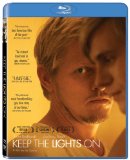| Reviews & Columns |
|
Reviews DVD TV on DVD Blu-ray 4K UHD International DVDs In Theaters Reviews by Studio Video Games Features Collector Series DVDs Easter Egg Database Interviews DVD Talk Radio Feature Articles Columns Anime Talk DVD Savant Horror DVDs The M.O.D. Squad Art House HD Talk Silent DVD
|
DVD Talk Forum |
|
|
| Resources |
|
DVD Price Search Customer Service #'s RCE Info Links |
|
Columns
|
|
|
Keep the Lights On

Please Note: The images used here are taken from promotional materials provided by Music Box Films, not the Blu-ray edition under review.
The latest feature from writer/director Ira Sachs (Forty Shades of Blue, Married Life), Keep the Lights On is the portrait of a relationship between two men -- documentary filmmaker Erik (Thure Lindhardt) and lawyer Paul (Zachary Booth, virtually unrecognizable from Dark Horse) -- who meet and fall in and out of love in a way it could only have happened in the film's setting (New York City) and timeframe (from approximately the late '90s through the late '00s). It is thus a particularly ambitious act of portraiture, one that simultaneously makes a brave attempt at a sort of sociological excavation/preservation (an effort that's of particular importance when it comes to the oft-overlooked or purposely ignored cultural specifics of minority communities, in this case gay men) and, additionally, means to do the same on the emotional level, bringing us in close to these two men with their flawed personalities and self-destructive habits both physical and psychological, moving us with the story of their failure to mesh despite their almost foolishly heroic efforts. What Sachs comes up with in casting his net so admirably wide is something that retains at least most of the interest it promises but has turned out lopsided, working noticeably better as a snapshot of a time and place than of two particular individuals and their very troubled, life-altering joint experience over a 10-year relationship. The film intrigues and engages at every turn, intermittently fulfilling its great potential, but it is a bit too diffused, too fuzzy to quite work in some significant respects. As a portrait, it's candid and probing in some commendable and rewarding ways (and with an impeccably observant and authentic sense of period-specific physical and behavioral detail), but it also at times withholds and evades, to the extent that it ultimately lacks enough focus to let us know its subjects and the power of their connection as deeply and intimately as it clearly intends to.
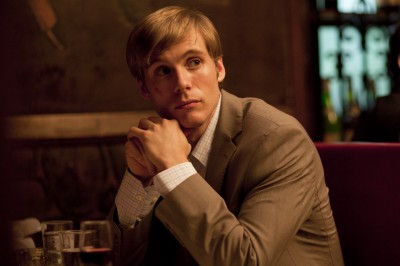
Sachs does make great use of his unequivocal assets, most salient among which are actors who have clearly immersed themselves fully in, and given themselves entirely over to, their characters, whether it's the principals (Lindhardt as the ambivalent, somewhat narcissistic Erik and Booth as the boyish, initially semi-closeted crack addict Paul) or the character actors (Paprika Steen as Erik's nagging, loving sister; Julianne Nicholson as his best friend). For the film's aptly conceived, warm-grainy, "intimate" 16 mm visual aesthetic, the cinematographer Thimios Bakatakis is an inspired choice, having already well proven his impressive visual chops on Yorgos Lanthimos's Dogtooth and Athina Tsangari's Attenberg. The somewhat ambivalent feeling (and not necessarily in the good way) that Keep the Lights On leaves you with has to be traced back, then, beyond the clear skill and commitment at work in the execution, to some evasiveness in the narrative conception, the story and plot that Sachs and co-writer Mauricio Zacharias have built their script upon. The film is divided into three sections, "1998," "2000," and "2006," apparently important periods during which we'll get the most revealing windows into the increasingly enabler/enabled, codependent dynamics between the lovers as they gradually fall in love over the course of their initial, intermittent meet-ups for sex, moving in together, and a series of failed expressions of concern, interventions, and rehab stints when attempting to cope with the recalcitrant Paul's drug addiction. But given what we're actually shown (too much of Erik and his work/social life, sometimes rather bland, or at least not very intense, frolicking-lovers images; too little of the less easily conveyed, day-by-day lived connection between the two), these divisions come to seem both dutiful and arbitrary; Sachs and Zacharias are good at giving us little moments that promise to let us into the strong love between the two men and the torture of its erosion under the strains of Paul's addictive behavior and Erik's self-willed blindness, but then they go back to scenes that are, less fruitfully, centered around the storyline of Erik's character development as he becomes a successful filmmaker. There's a rawness of feeling lurking underneath the lover's spats, exuberant (and then more routine, as per the patterns of cohabitating) lovemaking, and acts of drug-induced betrayal, but despite the handmade, home-movie look of the film, its reserves of compelling, personal/private pain and pleasure between two people never rises to the surface, as if Sachs and Zacharias are wrongheadedly trying to spare us the irrational delight and real, inconsolable anguish we're nevertheless expected to believe marks out Erik's and Paul's relationship as fecund territory for tragedy-tinged drama.
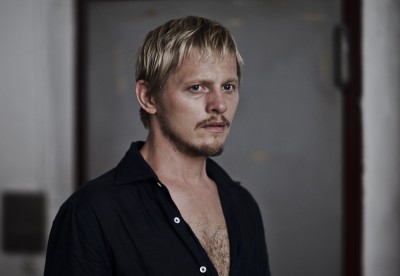
This problem, the film's main (and, I should stress, not wholly terminal) flaw, comes up because the writers have set themselves a trap -- a rather conventional story arc, with characters whom we're often not quite sure whether to regard as archetypical Urban Gay Men of their period or as individuals clearing their own path through the joys and hurts -- that they never manage to find a way out of. In other words, in choosing the narrative-dramatic path rather than setting themselves free to tap the emotion that can come from more focus on tone and well-filmed/assembled, less dialogue- and event-filled temps morts (a slower, more ambiguous, less plot-obligated kind of filmmaking, exemplified by European art film from Bergman to Haneke, that would've worked beautifully with the film's visual aesthetic), they line up slots for the kinds of cause-effect event and psychological information that a story-bound dramatic film requires, then fail to fill them in the way that this more traditionally dramatic storytelling approach needs to get a real hold on the viewer. Then there is another, parallel imbalance in the film's treatment of Erik's and Paul's relationship, which has as its origin a purely physical (phone-sex hookup, which also effectively signifies the bygone time) connection before developing into something more: Sachs laudably does not demure from forthrightly and nonchalantly including the joy of gay sex, rightly avoiding our culture's still too-common rank hypocrisy and double standards when it comes to depicting same-sex sexuality. But when it comes to the way it serves the film, we're left with the unfortunate feeling that the frank explicitness of the sex scenes, though they never seem gratuitous, is meant to compensate for the timidity (or outright elision) with which Sachs and Zacharias approach the dramatic conflict and the accompanying emotional pain felt by its two protagonists. Sachs's across-the-board use, in the film's score, of music by the intriguing late NYC avant-garde composer/pop musician Arthur Russell makes for a perfect encapsulation of both the kind of moody greatness the film hints it and its ultimate grounding at the hands of unsatisfactory convention: A creaking, melancholy loop-melody for what sounds like guitar and strings (as heard in the film's evocative trailer) is perfect, and used exclusively, could've proven a perfectly haunting, repetitive, unforgettable motif à la the guitar loop composed by Stuart Staples for Claire Denis's The Intruder. But Russell's music is all over the map, and Sachs overindulges his fandom for it to an extent that, by the time the glib, chipper track "This is How We Walk on the Moon" plays Erik down the street and us out of the film as it concludes, it feels both falsely upbeat and like a victim of that indie-film cliché, the overreliance on hip music to make up for a certain lack of insight or substance.
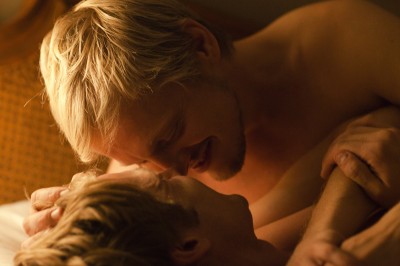
That is not to say that Keep the Lights On is insubstantial. It has much in it of great merit and accomplishment, and is worth seeing just to experience, as mentioned, the wonderful performances and the uniquely beautiful visuals (whether or not the film always earns or lives up to them). Its depths, such as they are, are worth wading into, but unfortunately, it frustrates in a way a lesser film wouldn't by taking you right up to, and then leaving you, just at that point before you really submerge and dig deep -- just within sight of something more unflinching, more profound and unsettling, and less conventional. Perhaps understandably, given that Sachs has been forthcoming about the film's autobiographical quality (he himself lived many of these events in a relationship with multiple similarities), the film is reluctant to dive into those colder, harsher, more clear-eyed waters that could've made it a masterpiece. But whatever the reasons, no matter how understandable or sympathetic, Keep the Lights On remains something with plentiful flashes of alluring brilliance and hints of power that in the end cannot or will not follow through on its vision rigorously enough to offer an experience as effective and affecting as it seems more than capable of. Its well-realized style and emotional-minefield subject matter promise things that the film comes up somewhat short in delivering, in the process transforming the film into something less great than it is a pleasing-enough but nigglingly incomplete object lesson whose moral is that to get to those greater qualities and reach as far under the audience's skin as you mean to, you have to be willing to take it all the way, all avoidance of discomfort and embrace of restraint be damned.
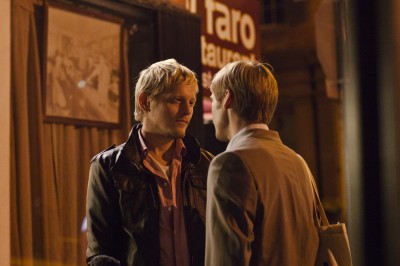
THE BLU-RAY DISC:
This transfer to Blu-ray (presenting the film at a 1.78:1 aspect ratio, slightly modified from its 1.85:1 theatrical AR) preserves the very particular, tonally very important grainy-celluloid feel of Thimios Bakatakasis's super-16 mm cinematography to perfect and glorious effect, meaning no over-zealous cleanup job has been done with digital tinkering, and it looks like film. It has been well vetted for any aliasing, edge enhancement/haloing, and retention of its warm color quality, natural-looking skin tones, and solidity of brighter and darker scenes to the extent that intentionally blurrier 16 mm renders solid darks. Overall, an excellent transfer that does the film and its unique visual treatment full justice.
Sound:The film's DTS-HD Master Audio soundtrack (incorrectly listed on the packaging as Dolby 5.1 surround) is clear, clean, and rich with the film's multiple sonic layers, from Arthur Russell's (perhaps too) prominently-used music to all of the dialogue and background/ambient sound all vividly present and minus even a single instance of imbalance, distortion, or sonic murkiness.
Extras:--A feature-length audio commentary with director/co-writer Ira Sachs, in which he reveals himself to be as sensitive and passionate as a commentator, artist, and human being as his bold taking on of this particular project might imply, openly sharing his own thoughts and feelings on -- and history with -- the material, his impressions and intentions for the preparation and production of the film, and some touchstones (citing Scorsese's New York films, Ken Loach and Maurice Pialat, and Cassavetes) he used while going about getting his vision onto the screen.
--In Search of Avery Willard (30 min.), an actual documentary by Cary Kehayan, made in conjunction with Keep the Lights On, that serves as the film within the film, the celebrated documentary made by "Erik Rothman." This supplement is a revelation; I, for one, had never heard of Avery, and assumed he was a fictional composite based in large part on Kenneth Anger. It turns out he was a real-life contemporary of Anger's who had had a much longer and more extensive career as a celebrity photographer (snapping Mae West and a young Colleen Dewhurst, among others), creator of homoerotic "physique" pictorial magazines, and filmmaker veering It's fascinating, historically and culturally invaluable stuff.
--The Making of Keep the Lights On (10 min.), a close-up behind-the-scenes short by Jean-Christophe Husson, with lots of glimpses of the shoot and interviews with Sachs and Lindhardt, discussing Sachs's approach to working his with actors when preparing for, and during, the shoot.
--Six minutes of deleted scenes (mostly further development of how the relationship between the two protagonists came to be and evolve), with optional commentary by Sachs.
--Audition tapes by both Lindhardt and Booth, a revealing glimpse at each actor's tryout takes on the characters they would eventually play in the film.
--The film's impressionistic teaser trailer.
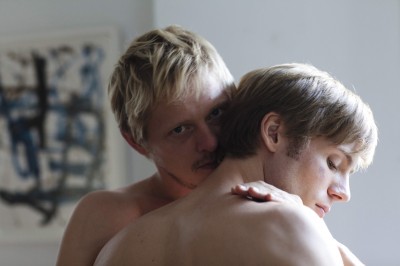
Keep the Lights On has some promising signs -- mostly on the aesthetic and performance levels -- that a great, emotionally devastating movie lurks within its slightly misassembled ingredients. Coming thiiiis close to making up for what the film lacks are two supremely dedicated, deep lead performances by actors Thure Lindhardt and Zachary Booth as the film's unlikely long-term couple, as well as director/co-writer Ira Sachs's concept of filming his relationship drama on warm, dirty-intimate, slightly grainy/blurry super-16 mm and his choice of the superlative Greek cinematographer Thimios Bakatakis (Dogtooth) to make that vision for the film's look and feel a reality. What draws Keep the Lights On's surge of promise back down a bit is nothing exactly fatal, just a steady swerving toward the middle of the road -- away from riskier, less narrative-bound aesthetic territory on one side and avoiding rawer emotions on the other, dramatic side -- on the part of Sachs and co-screenwriter Mauricio Zacharias. The result is something perfectly watchable and engaging, but frustratingly conventional, neither impressionistically emotional or dramatically probing in its adherence to a three-act plot arc -- a competent indie drama with more trappings (and music) and somewhat less substance and courage than it needs, belying the aforementioned traces of something a bit more searching, affecting, and inspired. The film's (autobiographical) story of a painful, ill-fated 10-year love affair between a filmmaker and a drug-addicted publisher in New York City doggedly follows its arc, but we only know that it's autobiographical because of the filmmaker's forthrightness about it in other venues, not through incisive observations or details, which are few and far between; it's only the roundly excellent acting by everyone involved that keeps the characters from often feeling like Stock Gay Couple with Creative-Field Jobs, Female Best Friend, etc. Sachs "keeps the lights on" for the (important, granted) physical/erotic dimension of the central relationship, with unabashedly explicit and honest, but not gratuitous, flirtations, seductions, and sex; unfortunately, he flinches away from the deeper psychological and emotional repercussions that the scenario hints at and that should be the payoff for its more conventionally dramatic trappings, falling short of fully tapping into the exhilarating joy and unbearable pain that these characters go through in their love and loss. Still, the film has multiple pleasures to offer, and the level at which it works best -- that of sociological snapshot of gay male dating, sex, and romance over a certain period in a particular time and place -- is nothing to dismiss, either. One does wish that Sachs had removed some of the (self?) protective layers that muffle what we see, in long glimpses, are the film's potential to strike deeper and leave a more indelible mark, but its unevenness and ultimate timidity don't cancel out its interest and frequent success, and for all that it does give us to experience visually and emotionally, Keep the Lights On can be Recommended, if slightly less highly than one might have hoped.
|
| Popular Reviews |
| Sponsored Links |
|
|
| Sponsored Links |
|
|
| Release List | Reviews | Shop | Newsletter | Forum | DVD Giveaways | Blu-Ray | Advertise |
|
Copyright 2024 DVDTalk.com All Rights Reserved. Legal Info, Privacy Policy, Terms of Use,
Manage Preferences,
Your Privacy Choices | |||||||









